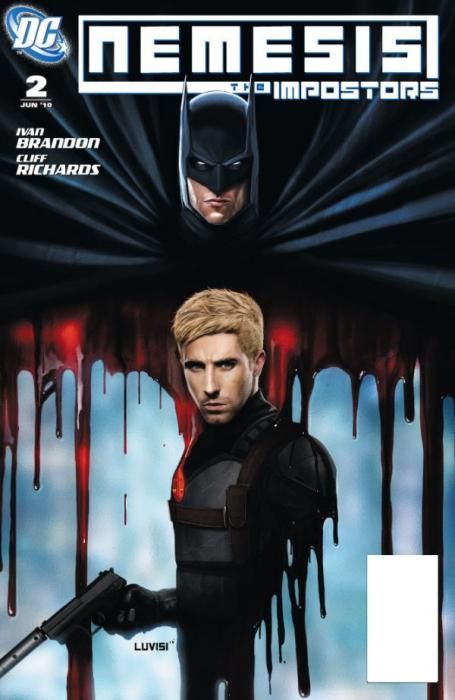It's cliche to say this, but Cliff Richards is doing career-best work on "Nemesis: The Imposters." After he replaced Marco Rudy on this series' predecessor, "Final Crisis Aftermath: Escape," Richards' art was serviceable albeit unspectacular. Here, though, inking himself, Richards' art is soft and haunting, more fluid and impressionistic. He also seems more playful, breaking free of panel borders, particularly in action scenes where he'll show a montage of images on a page that flow from one to the next. In his art is a look of unreality, of a dreamlike, false existence that mirrors the writing.
"Nemesis: The Imposters" #2 has Tom Tresser found by Batman after he and the Joker went off a cliff in his car. Ivan Brandon uses Batman to underscore the idea of fakes and imposters as Tresser immediately spots that this Batman isn't the real Batman -- or, at least, the Batman that's been around for years. It's a nice bit of commentary on the idea of replacement heroes being authentic. Is Dick Grayson truly Batman or is he just an imposter? Tresser thinks the latter, but where do we stand?
The feeling of paranoia introduced in the first issue carries over into this one nicely. Even with Batman, we don't know that he's really Dick Grayson. The Joker with Tresser was a fake, so why not someone else pretending to be Batman, playing off our knowledge that Grayson is new under the cowl? The introduction of the idea that the events of "Escape" never happened and that it's all in Tresser's head after it's revealed that the Justice League has been watching him for two years increases that feeling of edginess and paranoia. Everyone is watching him, tricking him, playing with him. It's easy to see why Tresser is so freaked out and willing to nearly kill Batman to escape.
Brandon's narration and dialogue skills push the comic forward along with Richards' great character work. A scene on the Batplane where Batman talks to Wonder Woman is handled perfectly as she comes across as compassionate and confused over Tresser's sudden turn, while he looks sullen and mystified that no one believes him. By shifting the story from Electric City to the regular DCU, Brandon has somehow managed to make Tresser's problems with the Global Peacekeeping Agency even weirder and tenser.
This issue, though, is a little light on plot. The revelations given are very good, but Tresser's interactions with Batman are a little drawn out. As well, Brandon's Batman sounds too similar to the Bruce Wayne version. That's possibly purposeful to heighten the reader's identification with Tresser's paranoia, but it doesn't seem like Dick Grayson beneath the cowl a lot of the time.
"Nemesis: The Imposters" is shaping up to be a strong sequel to "Escape" with both Ivan Brandon and Cliff Richards delivering great writing and art. Paranoia in the heart of the DCU makes for an interesting read and the final page manages to turn everything upside down once again.

